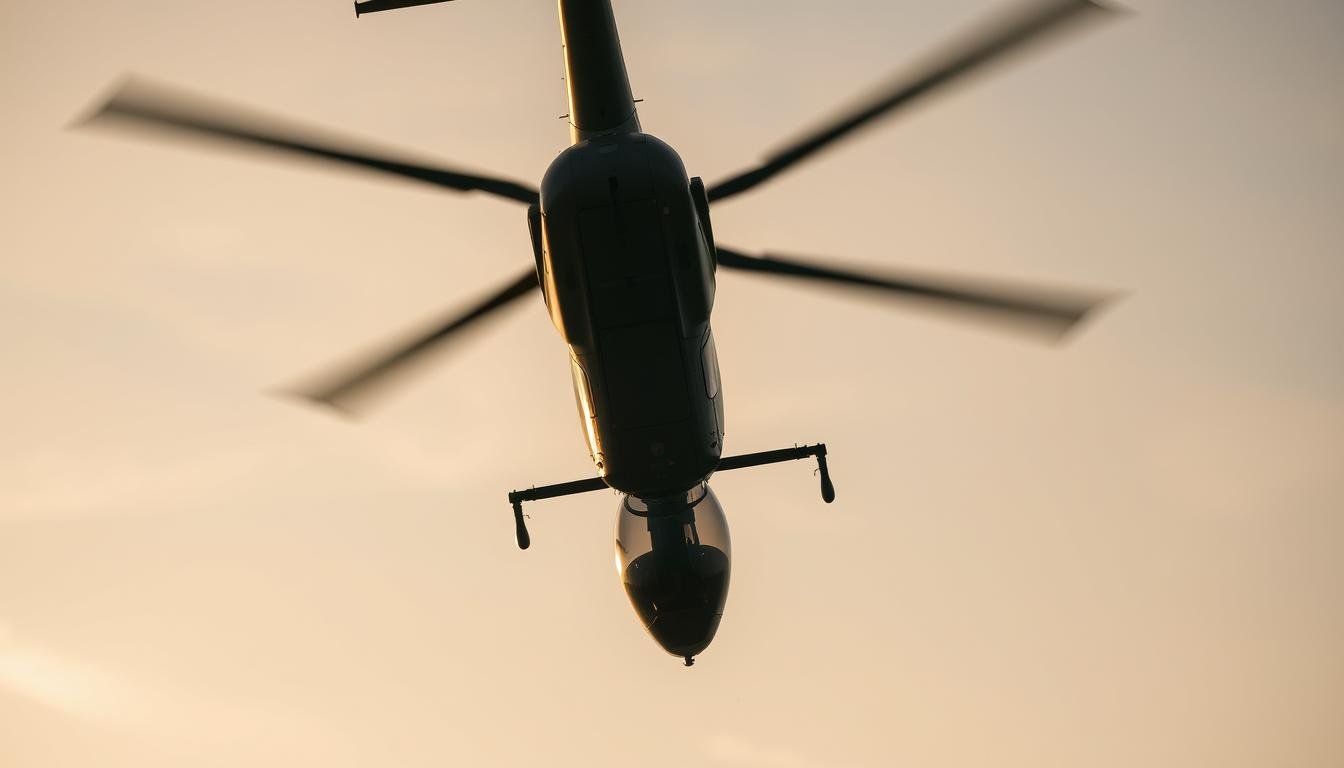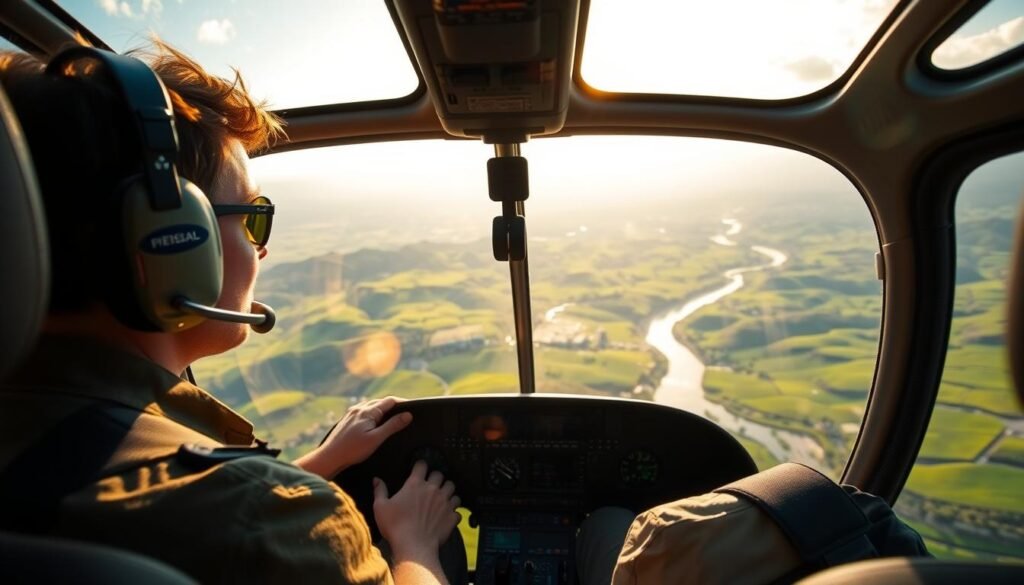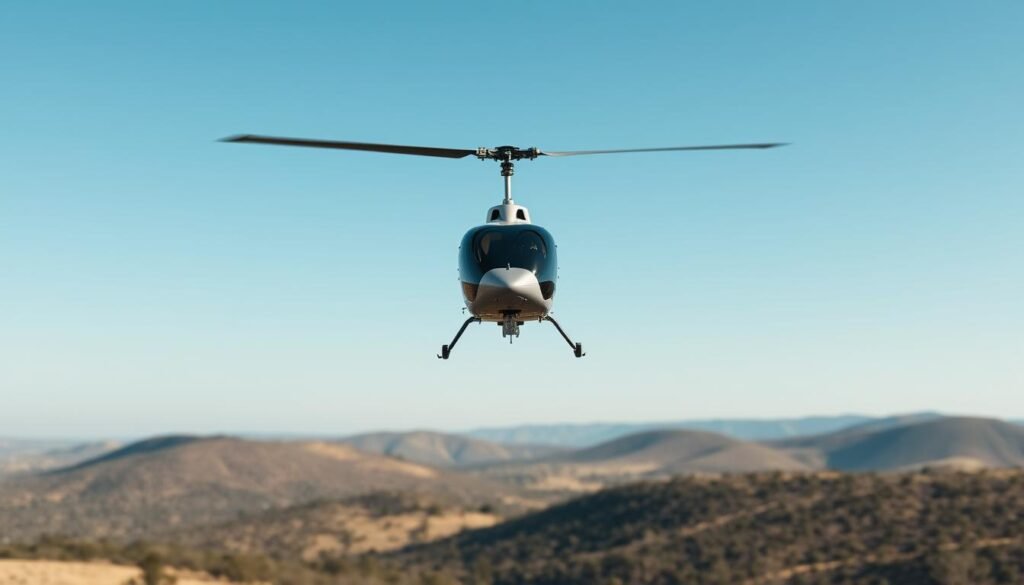Can Helicopters Fly Upside Down? That question grabs attention because dramatic airshow clips make inverted moments look routine.
Some machines, like the modified Red Bull BO105, have brief inverted segments in displays. The Westland Lynx has shown loops and rolls while keeping positive G. Forum pilots also note models can hover inverted by reversing blade pitch.
But this is not the daily reality. For most rotorcraft, sustained inverted flight sits well outside design and safety limits. Short, controlled passes through an inverted attitude are possible in specific aircraft with rigid rotors, special oil and fuel systems, and exact pilot technique.
This guide separates headline stunts from practical fact, explains how lift and rotor systems differ from airplanes, and previews why safety, airframe limits, and time spent inverted matter. For a deeper look at aileron-style rolls and the BO105 demonstrations, read this explainer.
Key Takeaways
- Brief inverted segments can occur in specially modified aircraft during aerobatic displays.
- Most helicopters are not designed for continuous inverted flight.
- Airshows like the BO105 and Lynx demos show what is rare, not routine.
- Design features—rigid rotors, dry sump oil, and fuel systems—enable limited stunts.
- Safety margins, G-loading, and pilot technique control how long an aircraft stays inverted.
- For more detail on barrel-roll style maneuvers, see a technical explainer.
Reference: detailed coverage of BO105 aerobatic demonstrations
Can Helicopters Fly Upside Down: What The Question Really Means
Viewers often mean different things when they ask if a rotorcraft can invert—hovering belly-up, cruising inverted, or a split-second stunt during a loop.
First, clarify the intent. Some ask whether a helicopter can hover inverted. Others ask if an aircraft can sustain an inverted cruise. A third group points to a single frame from an airshow clip.
Time and purpose matter. The theoretical answer allows brief inverted segments in a few rigid-rotor types. The practical answer is different: most helicopters cannot sustain an upside attitude for safety and mechanical reasons.
Video footage can mislead. A single inverted frame may come from a loop where the rotor stays loaded with positive G. That keeps the blades doing their job even when the fuselage nods past vertical.
- Airshow Versus Utility: Demo crews train for tight envelopes; SAR, EMS, and police pilots avoid inverted attitudes.
- Theory Versus Practice: The rotor can produce lift regardless of fuselage direction, but systems must stay within certified limits.
- Pilot And Authorization: Only specific aircraft and crews are cleared and trained to attempt brief inverted segments.
| Situation | Feasibility | Pilot Role |
|---|---|---|
| Momentary Inverted During Loop | Possible on select aerobatic rotorcraft | Highly trained display pilot |
| Sustained Inverted Cruise | Practically not supported | Not approved for operations |
| Hovering Inverted | Rare, requires special systems | Limited to experimental rigs |
| Sideways Flight | Routine and controllable | Standard pilot technique |
Understanding Lift, Rotors, And Controls In Upright And Inverted Flight
Rotors act as giant, rotating airfoils that push air downward to create lift and usable thrust. This basic theory explains why the fuselage attitude does not instantly remove lift: the disc must remain loaded.

How Rotors Generate Lift, Thrust, And Control In The Air
A rotor disc accelerates air downward; that momentum change produces lift. Many rotor systems spin near 500 rpm to maintain steady loading on the blades.
Collective, Cyclic, And Rotor Pitch: Translating Inputs To Direction
The swashplate varies blade pitch. Collective raises or lowers overall pitch to change thrust and climb rate. Cyclic tilts the disc to produce directional control and forward motion.
Positive Vs. Negative G And Why It Matters For Helicopters
Keeping positive G on the rotor keeps blades in tension. Negative G can unload blades, cause mast bumping on some hubs, and quickly remove control.
“Aerobatic rolls and loops aim to keep the rotor loaded so the hub and blades avoid overstress.”
- The rotor disc must stay loaded even when the aircraft briefly leaves upright attitude.
- Blades respond to aerodynamic effect and gyroscopic precession, so pilot inputs must be timed precisely.
- That mechanical reality limits how long helicopters fly inverted and who may attempt it.
For a deeper technical look at aerobatic demos, see this technical explainer, and for pilot transition notes consult a practical guide on moving from fixed wing to rotary.
Why Sustained Inverted Flight Is Rare: Engineering And System Constraints
Engineering limits, not pilot skill, often set the boundary for how long a rotorcraft can remain inverted. The rotor head and blade design control how forces move through the hub. Excessive flex can let blades strike the mast or top of the fuselage.

Rotor Head, Blade Rigidity, And Flex Limits In Inverted Flight
Most rotor hubs and blades are tuned for positive loading. A teetering or semi-rigid hub can suffer mast bumping under negative G, which causes sudden, catastrophic loads.
Longer blades and large rotors increase bending moments. That size and weight make sustained inverted segments far riskier for transport and utility models.
Engines, Fuel, And Lubrication Systems During Upside-Down Flight
Engines and gearboxes depend on gravity-fed oil pickups and fuel sumps. Running inverted for any meaningful time can starve pumps, reduce thrust, and damage components.
Some naval designs include limited negative collective to help with deck motion, but that authority is tiny. It does not provide the continuous support needed for true inverted flight.
“Aerobatic profiles keep positive G to protect the rotor system and feed critical systems that rely on gravity.”
- Mechanical Effect: Negative G unloads blades and upsets rotor dynamics.
- System Limits: Oil and fuel pickups fail long before the structure does in most types.
- Operational Reality: Rolls and loops are flown to maintain positive loading and avoid prolonged stress.
For a technical overview and examples of airframes certified for aerobatics, see this inverted flight explainer. It explains why such maneuvers remain exceptions, not the rule.
How Inverted Maneuvers Actually Work: Loops, Barrel Rolls, And Sideways Flight
Simple geometry and tight speed control let some rotorcraft pass through an inverted pose without unloading the disc. Pilots plan entry energy, load factor, and altitude to keep the rotor working the whole time. These moves remain rare and are flown only in approved aircraft and profiles.

Loop Basics: Brief Inverted Segments Under Positive G
In a loop the crew sets an entry speed and climbs with a smooth increase in collective. The goal is to keep positive G so the blades stay in tension.
Planned geometry and conservative load factors let the helicopter pass a short inverted segment while systems remain fed and the structure sees predictable loads.
Barrel Roll Dynamics: Maintaining Positive G To Protect The Rotor System
A properly flown barrel maintains positive G by blending roll and pitch inputs. A coordinated barrel roll preserves thrust and avoids rotor unloading.
“Positive-G management is the single most important factor in aerobatic rotary profiles.”
Flying Sideways And “On A Roll”: Cyclic, Collective, And Altitude Control
Sideways flight is routine: cyclic tilts the disc laterally while added collective holds altitude. The swashplate changes blade pitch for left-right control and keeps heading stable.
This technique aids confined-area work, SAR positioning, and observation. Only select helicopter types will ever briefly fly upside during a loop or barrel, and then under strict procedures.
Aircraft, Pilots, And Real-World Examples Of Inverted Flight
A small set of rotorcraft achieve controlled rolls by keeping the rotor loaded and systems fed throughout the maneuver.
Airframes And Demonstrations: The BO105, modified for Red Bull shows, and the Westland Lynx are the best-known examples of display aircraft that perform brief rolls and loops. Both types rely on rigid or very stiff rotor heads, precise maintenance, and fuel and oil modifications to tolerate short inverted segments.

Airframes And Demonstrations: BO105, Westland Lynx, And Red Bull Displays
The BO105 has a documented history in aerobatic displays and is often flown by experienced crews in tightly controlled profiles.
The Lynx demonstrated loops and rolls while holding positive G, showing how geometry and engineering let a helicopter pass a brief inverted pose without losing rotor tension.
Model choppers, with high power‑to‑weight and rigid heads, can sustain inverted hover — a reminder that full‑scale aircraft operate under very different limits.
Pilot Skill, Training, And Safety Culture: From Theory To Airshow Reality
Pilots train in simulators, then practice stepwise in the aircraft under strict oversight. This progression turns theoretical profiles into safe demos.
“Display flying pairs careful technique with rigorous maintenance and post‑flight inspections.”
Operational crews for EMS, police, and utility work prioritize safety margins every day. Their mission profiles avoid aerobatic risk and keep fatigue tracking and inspections central to airworthiness.
| Topic | Airshow Example | Operational Reality |
|---|---|---|
| Aircraft | BO105, Lynx | EMT, Police, Utility Types |
| Pilot Role | Specialist Display Pilot | Operational Pilot Focused On Safety |
| Maintenance | Enhanced Inspections | Standard Safety Checks |
- Time: Displays accept short, planned inverted time and follow strict post‑flight checks.
- Risk Management: Fatigue tracking and inspections limit cumulative stress on the airframe.
- Contrast With Airplanes: Airplanes often have wider aerobatic authority; a helicopter’s rotor head and blades decide whether any roll is allowable.
For an in-depth look at a signature display program, read the Red Bull feature on the BO105 going inverted.
How To Evaluate The Feasibility And Safety Of Upside-Down Maneuvers
Evaluating an aerobatic pass starts with hard data: approved limits, system capability, and recovery margins. Teams must translate those facts into a clear brief before any trial or display.

Preconditions Checklist: Airframe Limits, Speeds, Altitude, Weather, And Legalities
Airframe And Rotor: Confirm the airframe is certified or modified for aerobatic loads. Inspect rotor head stiffness, blade clearances, and mast tolerances.
Control Authority And Pitch: Verify cyclic and collective authority at the planned entry speeds. Ensure pitch margins allow recovery without exceeding structural limits.
Entry Speeds And Altitude: Set minimum entry speeds and an altitude buffer to provide time for recovery. Time is a safety buffer; it must be conservative.
- Weather And Direction: Assess wind, turbulence, and density altitude. These affect control response and rotor loading.
- Systems: Confirm oil and fuel pickups support transient attitudes. Naval negative collective modes are not substitutes for full inverted support.
- Regulatory And Insurance: Obtain waivers, pilot endorsements, and insurer approval. Legality and venue control are prerequisites.
- Human Factors: Check pilot currency, crew coordination, and pre-briefed abort procedures with safe exit directions.
| Item | Required Check | Why It Matters |
|---|---|---|
| Airframe Approval | Documentation/Mod List | Determines structural limits |
| Speeds & Altitude | Minimum Entry Speed; Recovery Altitude | Provides margin and time |
| Weather | Wind/Turbulence/Density | Affects control and rotor load |
Bottom Line: The practical answer favors restraint. Most helicopters lack system support for sustained inverted attitudes, so sideways and other low‑risk flight profiles remain the operational standard unless a strict approval process clears otherwise.
Conclusion
In practice, brief inverted moments are possible, but they remain exceptional.
Only select display aircraft with stiff rotors, modified systems, and expert pilots will pass briefly through inverted flight during a loop or roll. Most rotorcraft, due to blades, rotor heads, and fuel or oil constraints, are not built for sustained inverted attitudes.
Enjoy airshow maneuvers, but remember they rely on margin, maintenance, and strict technique. For a closer look at the stunt profiles and safety context, see this feature on aerobatic stunts and this review of ride safety.
FAQ
Is inverted helicopter flight possible?
Rarely. A few light attack and aerobatic models, such as the MBB/Westland BO105, have performed brief inverted segments during displays. Those maneuvers rely on precise energy management and airframes designed to tolerate unusual loads.
What prevents standard choppers from sustained inverted flight?
Structural limits in the rotor head and blades, rotorcraft control geometry, and engine lubrication and fuel systems usually block prolonged inverted operation. Traditional gear and systems assume positive G loads and upright orientation.
How do rotors create lift and control compared with fixed wings?
Main rotors produce lift by changing blade pitch as they spin. Pilots use collective to alter overall pitch and cyclic to tilt the rotor disc for directional control, unlike an airplane that uses fixed wings and separate control surfaces.
What roles do collective and cyclic inputs play during aerobatic maneuvers?
The collective adjusts total rotor thrust while the cyclic shifts the rotor disc to pitch, roll, or yaw the aircraft. Skilled pilots blend both to preserve positive G and avoid blade flapping or mast bumping during rapid attitude changes.
Why is positive versus negative G important for rotorcraft?
Positive G keeps the rotor system in tension and maintains predictable blade behavior. Negative G can unload blades, reverse flapping, and cause contact between rotating and stationary components, risking catastrophic failure.
Can a pilot perform a loop or barrel roll safely in a rotorcraft?
Short loops and properly executed barrel rolls have been demonstrated by trained crews in specific helicopters. Safety depends on aircraft certification, entry speed, altitude margin, and strict adherence to approved maneuver envelopes.
Do engines and fuel systems need modification for inverted segments?
Often yes. Standard fuel and oil systems rely on gravity and scavenging designs that fail if orientation reverses. Aerobatic-capable machines use pumps, tanks, and sumps rated for negative or variable-G to maintain flow.
What design features help a rotorcraft tolerate unusual attitudes?
Reinforced rotor heads, limited blade hinge freedom, robust lubrication systems, and flight control authority tailored for high maneuvering loads all contribute. The BO105 and similar types incorporate many of these elements.
How important is pilot training for inverted or aerobatic helicopter flight?
Crucial. Pilots must master energy management, precise control timing, and emergency recovery techniques. Airshow teams undergo intensive, recurrent training focused on both maneuver execution and safety protocols.
Are there legal or regulatory limits on performing inverted maneuvers?
Yes. Aviation authorities and airshow organizers impose strict limits. Pilots must comply with operating manuals, type certificates, and event safety rules, and they often need special permissions or waivers.
Which real-world examples demonstrate inverted capability in rotorcraft?
The MBB/Westland BO105 and some modified light helicopters used in airshows are well-documented examples. Red Bull Flugtag displays and military demonstration teams have also showcased brief, controlled inverted elements.
What checklist items determine if a maneuver is feasible and safe?
Verify airframe and rotor limits, check approved speed and altitude ranges, confirm fuel and oil system suitability, assess weather and wind, ensure pilot currency and clearances, and plan abort options before attempting any aerobatic action. rolls, but even they cannot maintain inverted flight for long periods. The rotor blade design, engine systems, and fuel mechanisms all prevent helicopters from flying upside down like airplanes. Ultimately, helicopters excel in their ability to hover, take off vertically, and navigate tight spaces—but flying upside down is a feat reserved for aerobatic stunts, not sustained flight.
Related Articles
- Can Anyone Learn to Fly a Helicopter? Understanding Training and Skills Required
- Why Do Helicopters Make That Distinctive Sound? Helicopter Noise Explained
- Do Helicopters Require More Maintenance Than Airplanes? Separating Fact from Fiction
- How Far Can Helicopters Travel? Dispelling Range Myths
- What Happens if a Helicopter Engine Fails? Debunking Catastrophe Myths
More from This Category
- Are Helicopters More Dangerous Than Planes? A Safety Comparison
- Do Helicopters Have Parachutes? Exploring Emergency Systems
- Can Helicopters Fly Upside Down? The Truth Behind Aerobatic Stunts
- Do Helicopters Need a Runway? Myth vs. Reality
- How Much Does It Really Cost to Fly a Helicopter? Busting the Myths
- How High Can Helicopters Fly? Debunking Altitude Myths
- Can Helicopters Fly in Bad Weather? Understanding Helicopter Capabilities
- Do Helicopters Really Hover Forever? Separating Fact from Fiction
- How Safe Are Helicopters? Debunking Common Misconceptions
- Top 10 Myths About Helicopter Safety: What You Need to Know



